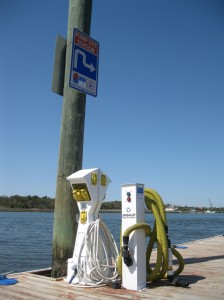By PAM SMITH
Boaters cruising southeastern North Carolina’s coastal waters also are navigating new rules governing disposal of boat sewage.
An Environmental Protection Agency ruling requires boaters with onboard toilets to dispose of waste only at designated pump-out facilities in the three-county area.
The No Discharge Zone (NDZ) includes all tidal salt waters extending three nautical miles into the Atlantic Ocean along the entire length of Brunswick, Pender and New Hanover counties. The ruling encompasses the Intracoastal Waterway, as well as tributaries, tidal creeks and all “saline waters” of the Cape Fear River in Brunswick and New Hanover counties.
New Hanover’s no-discharge designation came a year ago, but was broadened with the most recent EPA three-county ruling.
The ruling prohibits the dumping of treated and untreated sewage, but does not restrict the discharge of gray water from showers or sinks.
Along with banning deliberate dumping of marine sewage, the ruling requires boaters to secure all marine sanitation devices (MSDs) to prevent discharge when navigating or docked in any NDZ.
BY THE NUMBERS
To be effective, a zone must have adequate facilities for the safe and sanitary removal and treatment of sewage. The 15 marinas in the three-county area meet EPA’s criteria, according to the N.C. Department of Environmental Resources’ Division of Water Quality. An additional four South Carolina marinas are within five nautical miles of the designated NDZ.
N.C. Wildlife Resources Commission records show 28,400 boats are registered in Brunswick, Pender and New Hanover counties. In addition, about 540 transient boats cruise the NDZ waters each year. EPA estimates that about 4,333 of the total 28,940 vessels are equipped with an MSD. By EPA calculations, that means that each of the 15 pump-out facilities could adequately service an average of 289 boats per month.
WATER QUALITY
“The intent is to protect water quality,” says Gloria Putnam, North Carolina Sea Grant water quality planning specialist. “If it keeps bacteria and other pollutants out of the water, it is a good thing.”
New Hanover’s initial push for the NDZ designation began with Wrightsville Beach officials’ concern about frequent swimming advisories due to high bacteria counts in Banks Channel. University of North Carolina Wilmington researchers found evidence of human waste attributed to the concentration of boaters.
Steve Dellies, Wrightsville Beach stormwater manager, says his town plans to conduct follow-up studies to determine if there has been a reduction in human fecal bacteria since the NDZ was put in place.
GETTING THE WORD OUT
“Educating the boating community is essential,” says Pat Durrett, N.C. Division of Coastal Management’s Clean Marina Program coordinator. “We are targeting all marinas with information on the No Discharge Zone ruling.”

Boaters in No Discharge Zone waters will be on the lookout for pump-outstations such as this one at Joyner Marina on the Intracoastal Waterway at Carolina Beach. Photo by Pam Smith.
At a recent Wilmington workshop, about 40 boaters and marina managers learned the nuts and bolts of the EPA rule, its implications, kinds of pump-out devices and available resources.
Public and private marinas within an EPA-designated NDZ also must comply with the N.C. Clean Coastal Water and Vessel Act that states that, effective April 1, 2011: “A marina that has docking facilities and has more than 10 wet slips for vessels of 26 feet or more that have marine sanitation devices” must either install a pump-out facility or contract for the service. Marine operators must maintain pump-out facility and service records.
The North Carolina statute also states that: “Any owner or operator of a vessel that has a marine sanitation device shall maintain a record of the date of each pump-out of the marine sanitation device and the location of the pump-out facility. Each record shall be maintained for a period of one year from the date of the pump-out.”
“Our feedback has been positive,” Durrett says.
Some participants have inquired about applying for pump-out grants. DCM offers technical assistance and administers grants to help cover the cost of installing marine sewage pump-out stations. Marina operators may earn 75 percent of the cost, up to $15,000.
Durrett says more information about the No Discharge Zone is in the newest edition of A Boater’s Guide to Protecting North Carolina’s Coastal Resources, available on the DCM’s Clean Marina website.
Failure to comply with the guidelines could result in a $375 fine for the first offense. Enforcement agencies include the U.S. Coast Guard, N.C. Marine Patrol, N.C. Wildlife Resources Commission and local law enforcement officers.
For more information about the Clean Marina Program, the pump-out grant program and the No Discharge Zone, go to: www.ncoastalmanagement.net.
This article was published in the Spring 2011 issue of Coastwatch.
For contact information and reprint requests, visit ncseagrant.ncsu.edu/coastwatch/contact/.
